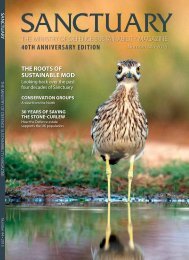SUSTAINABILITY
UC30G
UC30G
Create successful ePaper yourself
Turn your PDF publications into a flip-book with our unique Google optimized e-Paper software.
FEATURES<br />
use of all indiscriminate means of<br />
capture and killing. The common<br />
toad is also listed as a Species of<br />
Principal Impor tance for Nature<br />
Conser vation in England.<br />
To replace the loss of the breeding<br />
ponds, terrestrial foraging and<br />
hibernation areas, two existing large<br />
ponds were restored, three large ponds<br />
and new tussocky bunds and<br />
hibernacula were created. The new<br />
terrestrial foraging bunds, seeded with<br />
wildflower species, is a third larger than<br />
the terrestrial foraging ground lost<br />
within the demolition area. The<br />
creation of new and the restored ponds<br />
will contribute to the local Biodiversity<br />
Action Plans for both newts and ponds.<br />
One target for the local Biodiversity<br />
Action Plan for ponds is to restore 142<br />
degraded pond sites by 2026, and this<br />
project has contributed two ponds<br />
within one year.<br />
During the project, exclusion fencing,<br />
pitfall traps and refugia were installed<br />
to enable the ecologists to catch all of<br />
the GCN and other amphibians before<br />
the works began. The population of<br />
GCN present on site required a<br />
minimum of 60 days trapping under<br />
Natural England guidelines before the<br />
area could be considered clear of<br />
amphibians. During the trapping<br />
period a total of 131 GCN, 50 smooth<br />
newts, 4 frogs and 323 toads were<br />
caught and moved to suitable habitat<br />
away from the remediation area. To<br />
ensure that the amphibians do not<br />
Common toad © Crown<br />
Restored pond © Steve Edwards<br />
return to the demolition area,<br />
permanent exclusion fencing was<br />
installed, preventing the amphibians<br />
from colonising any new craters which<br />
will be formed as the normal<br />
operations continue.<br />
To facilitate the work s the Royal<br />
Engineers were called in from Bicester<br />
to under take the habitat creation and<br />
ecological enhancements whilst<br />
restoring the demolition area for<br />
operations and training. The work<br />
was conducted over four phases with<br />
Phase 1 seeing a total of 3,320m 3 of<br />
spoil being removed having dug<br />
down to the deepest point of 2m,<br />
weighing in at 4,824 tonnes which<br />
then had to be relocated on site until<br />
reused for landscaping. Phase 2 saw<br />
the excavation of the new ponds.<br />
Phase 3 was to restore the demolition<br />
ground and Phase 4 is to maintain the<br />
demolition ground to ensure the GCN<br />
do not return to the impact area. By<br />
March 2015, the plant work s were<br />
completed and the demolition<br />
ground handed back to DEMS Trg<br />
Regt fully operational, with a new<br />
purpose built habitat for the new ts<br />
to thrive in.<br />
All in all, this project took over two years<br />
to complete successfully, with the<br />
involvement of many stakeholders.<br />
These included the on-site DM Kineton<br />
personnel, DEMS personnel, the Royal<br />
Engineers, CarillionAmey (Regional<br />
Prime Contractor) and Middlemarch Ltd.<br />
Steve Edwards<br />
Sustainability Development Offcer<br />
DM Kineton<br />
Sanctuary 44 • 2015<br />
33



